warning light Peugeot Bipper 2015 Owner's Manual
[x] Cancel search | Manufacturer: PEUGEOT, Model Year: 2015, Model line: Bipper, Model: Peugeot Bipper 2015Pages: 192, PDF Size: 7.97 MB
Page 4 of 192
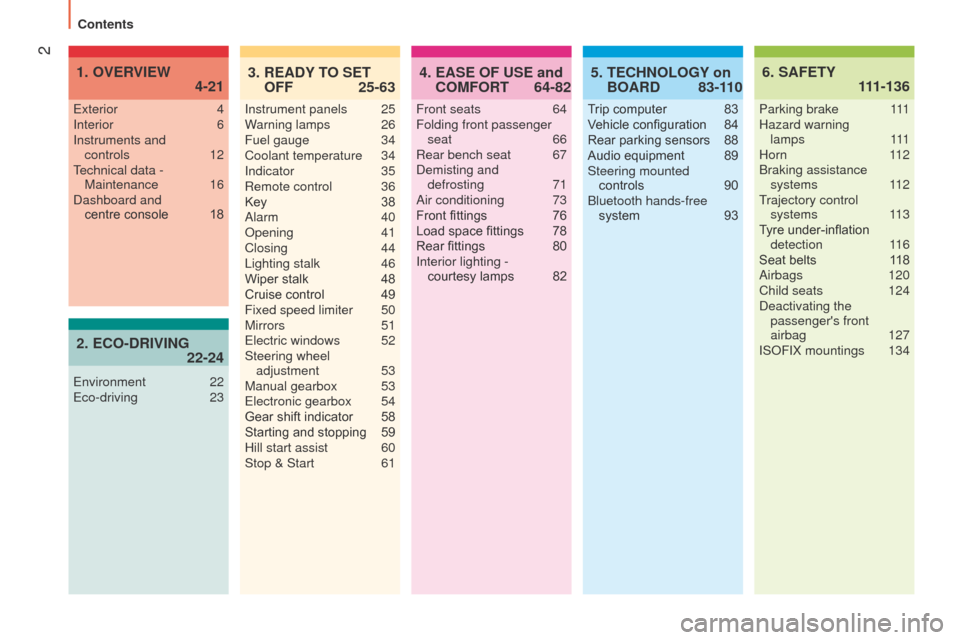
2
Bipper_en_Chap00a_sommaire_ed02-2014
EASE OF USE and
COMFORT
4. 64-82 SAFETY
6.
111-136
Front seats 64
Folding front passenger seat
66
Rear bench seat
67
Demisting and defrosting
71
Air conditioning
73
Front fittings
76
Load space fittings
78
Rear fittings
80
Interior lighting - courtesy lamps
82
e
xterior
4
Interior
6
Instruments and controls
12
technical data - Maintenance
16
Dashboard and centre
console
18
OVERVIEW
1.
4-21
Parking brake 1 11
Hazard warning lamps
111
Horn
112
Braking assistance systems
112
trajectory control systems
113
Tyre under-inflation detection
1
16
Seat belts
1
18
Airbags
120
Child seats
124
Deactivating the passenger's front
airbag
127
ISOFIX mountings
134
TECHNOLOGY on
BOARD
5. 83-1
10
Trip computer 83
V ehicle configuration 84
Rear parking sensors
88
Audio equipment
89
Steering mounted controls
90
Bluetooth hands-free system
93
READY TO SET
OFF
3.
25-63
Instrument panels 25
W arning lamps 26
Fuel gauge
34
Coolant temperature
34
Indicator
35
Remote control
36
Key
38
Alarm
40
Opening
41
Closing
44l
ighting stalk
46
Wiper stalk
48
Cruise control
49
Fixed speed limiter
50
Mirrors
51
e
lectric windows
52
Steering wheel adjustment
53
Manual gearbox
53e
lectronic gearbox
54
Gear shift indicator
58
Starting and stopping
59
Hill start assist
60
Stop & Start
61
ECO-DRIVING
2.
22-24
environment 22e
co-driving 23
Contents
Page 14 of 192
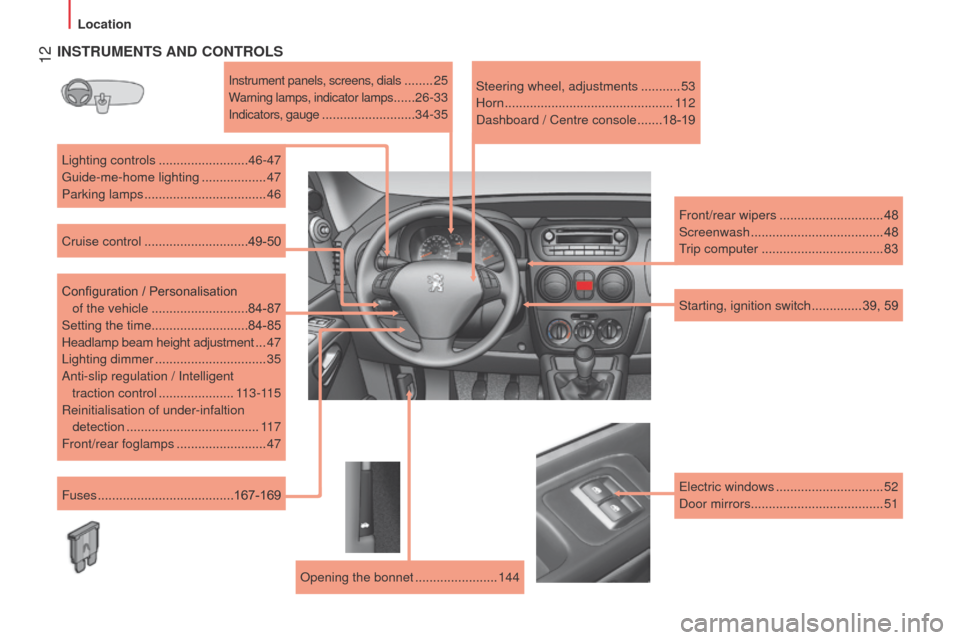
12
Bipper_en_Chap01_vue-ensemble_ed02-2014
INSTRUMENTS AND CONTROLS
Instrument panels, screens, dials ........25
Warning lamps, indicator lamps ......26-33
Indicators, gauge .......................... 34-35Steering wheel, adjustments
...........
53
Horn ...............................................
11 2
Dashboard / Centre console .......18-19
l
ighting controls
......................... 46-47
g
uide-me-home lighting
.................. 47
Parking lamps
.................................. 46
Cruise control
............................. 49-50
Configuration / Personalisation
of the vehicle
...........................84-87
Setting the time........................... 84-85
Headlamp beam height adjustment
... 47
l
ighting dimmer
............................... 35
Anti-slip regulation / Intelligent traction control
..................... 113-115
Reinitialisation of under-infaltion detection
.......
.............................. 11 7
Front/rear foglamps
......................... 47
Fuses
...................................... 167-169
Opening the bonnet
....................... 144 Starting, ignition switch
..............39, 59
Front/rear wipers
.............................48
Screenwash
.....................................48
trip computer
..................................83
e
lectric windows
..............................52
Door mirrors
.....................................51
Location
Page 16 of 192
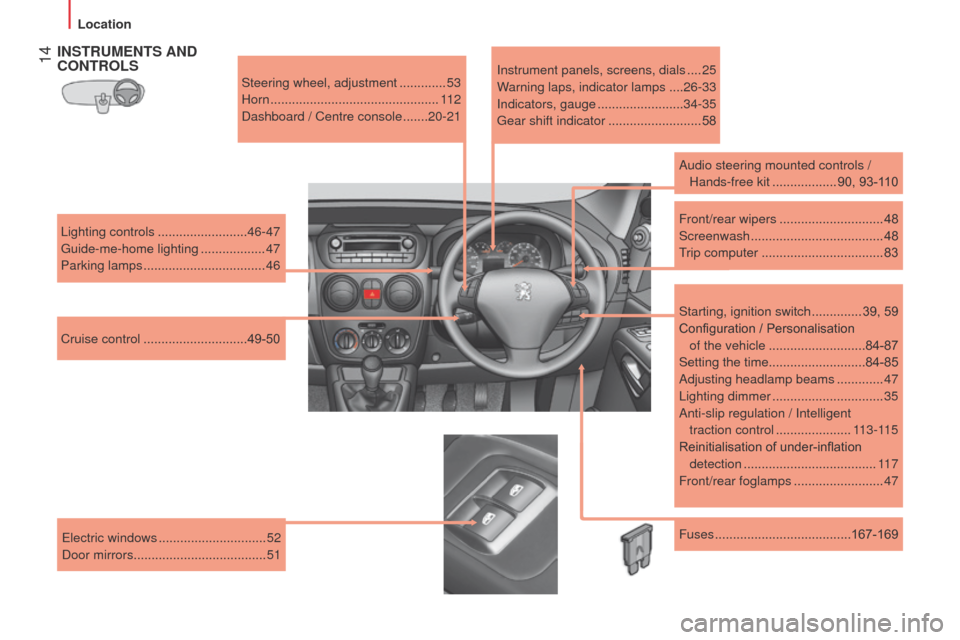
14
Bipper_en_Chap01_vue-ensemble_ed02-2014
INSTRUMENTS AND
CONTROLS
Steering wheel, adjustment .............53
Horn ............................................... 11 2
Dashboard / Centre console
.......20-21
l
ighting controls
......................... 46-47
g
uide-me-home lighting
.................. 47
Parking lamps
.................................. 46
Cruise control
............................. 49-50 Instrument panels, screens, dials
....
25
Warning laps, indicator lamps .... 26-33
Indicators, gauge
........................ 34-35
g
ear shift indicator
..........................58
Audio steering mounted controls / Hands-free kit
..................90, 93-110
Front/rear wipers
.............................48
Screenwash
.....................................48
trip computer
..................................83
Starting, ignition switch
..............39, 59
Configuration / Personalisation
of the vehicle
...........................84-87
Setting the time........................... 84-85
Adjusting headlamp beams
.............47
l
ighting dimmer
...............................35
Anti-slip regulation / Intelligent traction control
.....................113-115
Reinitialisation of under-inflation detection
.......
..............................11 7
Front/rear foglamps
.........................47
Fuses
......................................167-169
e
lectric windows
.............................. 52
Door mirrors
..................................... 51
Location
Page 33 of 192

31
Bipper_en_Chap03_pret-a-partir_ed02-2014
Warning lampisindicates Solution - action
Sidelamps on.a manual selection.
turn the ring on the lighting control stalk to the
first position.
Dipped beam
headlamps on.a manual selection.
turn the ring on the lighting control stalk to the
first position.
Main beam headlamps a pull on the control stalk.Pull the lighting control stalk to return to dipped
beam.
Direction indicators flashing with an
audible signal.a change of direction
using the lighting control
stalk.
to the Right: press the stalk upwards.to the
l eft: press the stalk downwards.
Hazard warning lamps flashing with an
audible signal.
the hazard warning lamp switch,
located in the middle of the
dashboard, has been pressed.the left and right direction indicators, and the
associated warning lamps, flash simultaneously .
Front foglamps on.that the button on the
dashboard has been
pressed. Manual selection.
t
he foglamps only operate if the sidelamps or
dipped beam headlamps are on.
Rear foglamps on.that the button on the
dashboard has been
pressed. Manual selection.
the foglamps only operate if the dipped beam headlamps are
on. When visibility is normal, switch the foglamps of f.
3
READY TO SET OFF
Instruments and controls
Page 37 of 192
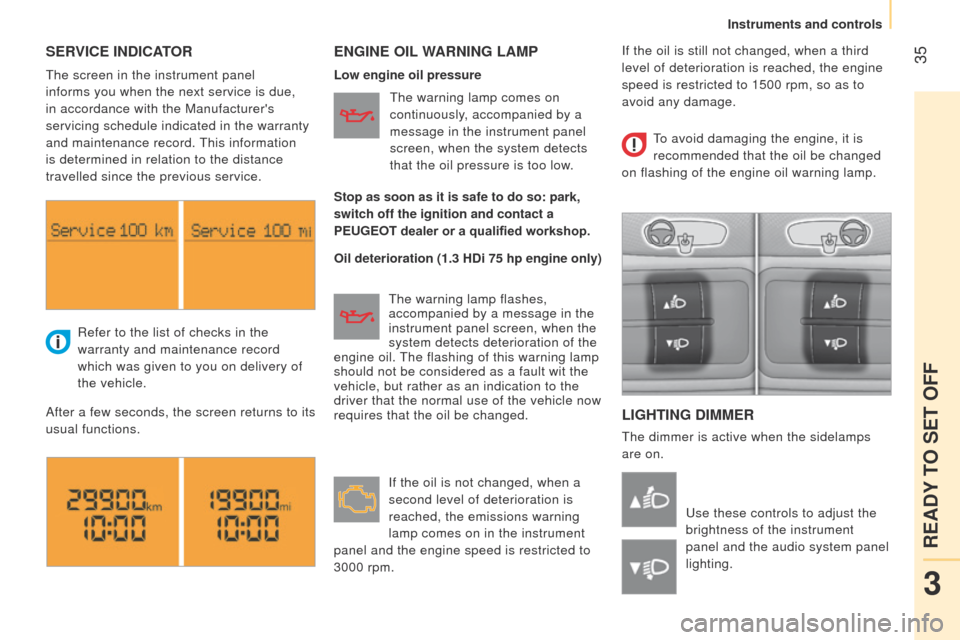
35
Bipper_en_Chap03_pret-a-partir_ed02-2014
SERVICE INDICATORENGINE OIL WARNING LAMP
L IGHTING DIMMER
the dimmer is active when the sidelamps
are on.
Refer to the list of checks in the
warranty and maintenance record
which was given to you on delivery of
the vehicle.
After a few seconds, the screen returns to its
usual functions.
u
se these controls to adjust the
brightness of the instrument
panel and the audio system panel
lighting.
t
he screen in the instrument panel
informs you when the next service is due,
in accordance with the Manufacturer's
servicing schedule indicated in the warranty
and maintenance record.
t
his information
is determined in relation to the distance
travelled since the previous service. Low engine oil pressure
Oil deterioration (1.3 HDi 75 hp engine only)
t
he warning lamp comes on
continuously, accompanied by a
message in the instrument panel
screen, when the system detects
that the oil pressure is too low.
t
he warning lamp flashes,
accompanied by a message in the
instrument panel screen, when the
system detects deterioration of the
engine oil.
t
he flashing of this warning lamp
should not be considered as a fault wit the
vehicle, but rather as an indication to the
driver that the normal use of the vehicle now
requires that the oil be changed.
If the oil is not changed, when a
second level of deterioration is
reached, the emissions warning
lamp comes on in the instrument
panel and the engine speed is restricted to
3000 rpm.
to avoid damaging the engine, it is
recommended that the oil be changed
on flashing of the engine oil warning lamp.
Stop as soon as it is safe to do so: park,
switch off the ignition and contact a
PEUGEOT dealer or a qualified workshop. If the oil is still not changed, when a third
level of deterioration is reached, the engine
speed is restricted to 1500 rpm, so as to
avoid any damage.
3
READY TO SET OFF
Instruments and controls
Page 48 of 192
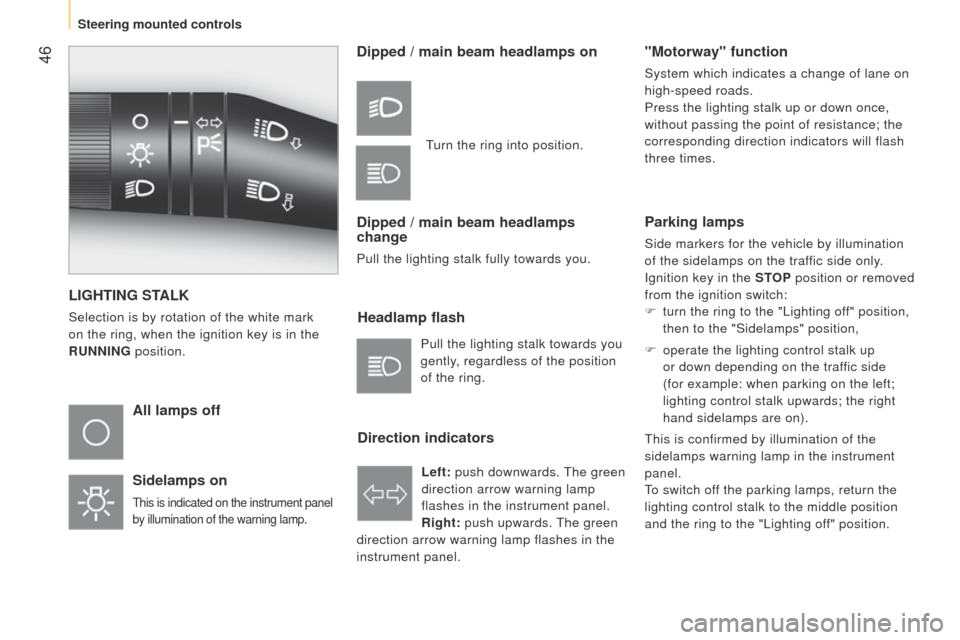
46
Bipper_en_Chap03_pret-a-partir_ed02-2014
LIGHTING STALK
Selection is by rotation of the white mark
on the ring, when the ignition key is in the
RUNNING position.
All lamps off
Sidelamps on
this is indicated on the instrument panel
by illumination of the warning lamp.
Dipped / main beam headlamps on
Dipped / main beam headlamps
change
Pull the lighting stalk fully towards you.
Headlamp flash
Direction indicators "Motorway" function
System which indicates a change of lane on
high-speed roads.
Press the lighting stalk up or down once,
without passing the point of resistance; the
corresponding direction indicators will flash
three times.
Pull the lighting stalk towards you
gently, regardless of the position
of the ring. Left: push downwards.
t
he green
direction arrow warning lamp
flashes in the instrument panel.
Right: push upwards.
t
he green
direction arrow warning lamp flashes in the
instrument panel.
turn the ring into position.
Parking lamps
Side markers for the vehicle by illumination
of the sidelamps on the traffic side only.
Ignition key in the STOP position or removed
from the ignition switch:
F
turn the ring to the "
l ighting off" position,
then to the "Sidelamps" position,
F
operate the lighting control stalk up
or down depending on the traffic side
(for example: when parking on the left;
lighting control stalk upwards; the right
hand sidelamps are on).
t
his is confirmed by illumination of the
sidelamps warning lamp in the instrument
panel.
to switch of
f the parking lamps, return the
lighting control stalk to the middle position
and the ring to the "
l ighting off" position.
Steering mounted controls
Page 49 of 192

47
Bipper_en_Chap03_pret-a-partir_ed02-2014
Headlamp beam
You are advised to adjust the height of the
headlamp beams in accordance with the
load in your vehicle.
t
his function can only be accessed in
the main beam headlamps and dipped
headlamps position.
Press these controls, located
on the dashboard, several times
in succession to adjust the
headlamps.
Foglamps
the controls are located in the dashboard
switch panel.
Front and rear foglamps
the foglamps should only be used in
fog or when snow is falling.
In clear weather or in rain, both day and
night, lit rear fog lamps dazzle and are
prohibited.
Do not forget to switch them off when they
are no longer necessary.
Guide-me-home lighting
the temporary maintaining of the dipped
beam headlamps, after switching of f the
vehicle's ignition, makes the driver's exit
easier when the light is poor by illuminating
the space in front of the vehicle.
Activation
With the ignition key in the STOP position
or removed, pull the lighting stalk towards
the steering wheel within 2 minutes after
switching off the engine.
e
ach time the control is operated, the
duration for which the lamps will remain
on is extended by 30 seconds, up to a
maximum of 210 seconds. Once this period
of time has elapsed, the lamps switch off
automatically.
Deactivation
Pull the lighting stalk towards the steering
wheel for more than 2 seconds.
t
he front foglamps operate with
the sidelamps and the dipped
beam headlamps.
t
he rear foglamps operate with
the dipped beam headlamps.
Press one of these controls to switch on the
lamps.
t
he warning lamp comes on,
accompanied by a message in the
screen, the first time the control is
operated and remains on until the
function is deactivated automatically. An indicator lamp in the screen
indicates the adjustment position
selected (0, 1, 2, 3).
3
READY TO SET OFF
Steering mounted controls
Page 63 of 192
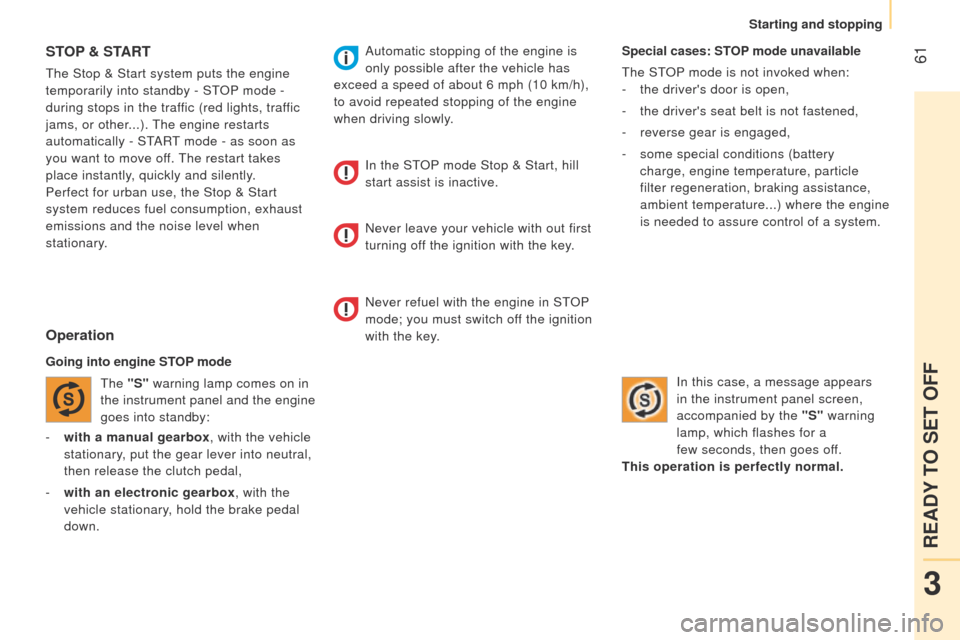
61
Bipper_en_Chap03_pret-a-partir_ed02-2014
- with a manual gearbox, with the vehicle
stationary, put the gear lever into neutral,
then release the clutch pedal,
-
with an electronic gearbox
, with the
vehicle stationary, hold the brake pedal
down. Special cases: STOP mode unavailable
t
he S t
OP
mode is not invoked when:
-
the driver's door is open,
-
the driver's seat belt is not fastened,
-
reverse gear is engaged,
-
some special conditions (battery
charge, engine temperature, particle
filter regeneration, braking assistance,
ambient temperature...) where the engine
is needed to assure control of a system.
In this case, a message appears
in the instrument panel screen,
accompanied by the "S" warning
lamp, which flashes for a
few seconds, then goes off.
This operation is perfectly normal.
STOP & S TART
the Stop & Start system puts the engine
temporarily into standby - S t
OP
mode -
during stops in the traffic (red lights, traffic
jams, or other...).
t
he engine restarts
automatically - S
t
ARt mode - as soon as
you want to move off.
t
he restart takes
place instantly, quickly and silently.
Perfect for urban use, the Stop & Start
system reduces fuel consumption, exhaust
emissions and the noise level when
stationary.
Operation
Going into engine STOP mode
t
he "S" warning lamp comes on in
the instrument panel and the engine
goes into standby: Automatic stopping of the engine is
only possible after the vehicle has
exceed a speed of about 6 mph (10 km/h),
to avoid repeated stopping of the engine
when driving slowly.
In the S t
OP
mode Stop & Start, hill
start assist is inactive.
Never leave your vehicle with out first
turning off the ignition with the key.
Never refuel with the engine in S
t
OP
mode; you must switch off the ignition
with the key.
3
READY TO SET OFF
Starting and stopping
Page 114 of 192

11 2
Bipper_en_Chap06_securite_ed02-2014
HORN
Press the centre of the steering wheel.
Anti-lock braking system and
electronic brake force distribution
linked systems which improve the stability
and manoeuvrability of your vehicle when
braking, in particular on poor or slippery
surfaces.
BRAKING ASSISTANCE SYSTEMS
group of supplementary systems which help
you to obtain optimum braking in complete
safety in emergency situations:
-
anti-lock braking system (ABS),
-
electronic brake force distribution
(
e BFD),
-
emergency braking assistance (
e BA).Activation
t
he anti-lock braking system comes into
operation automatically when there is a risk
of wheel lock.
Normal operation of the ABS may make
itself felt by slight vibration of the brake
pedal accompanied by some noise.
When braking in an emergency
, press
very firmly without releasing the
pressure.
Operating fault If this warning lamp comes on,
accompanied by an audible signal
and a message in the instrument
panel screen, it indicates a fault
with the anti-lock braking system which
could result in loss of control of the vehicle
when braking. If this warning lamp comes on,
together with the ABS warning
lamp, accompanied by a message
in the instrument panel screen,
it indicates a fault with the electronic brake
force distribution which could result in loss
of control of the vehicle when braking.
You must stop as soon as it is safe to do so.
Good practice
t
he ABS system does not provide shorter
braking distances. On very slippery surfaces
(black ice, oil...) the ABS can extend braking
distances. For emergency braking, press the
brake pedal hard and do not release it, even
on a slipper surface; you will then be able to
steer the vehicle and avoid an obstacle.
When replacing wheels (tyres and
rims), ensure that they conform to the
manufacturer's recommendations. In either case, contact a P euge O t
dealer
or a qualified workshop.
For maximum braking efficiency, a
bedding-in period of around 300 miles
(500 kilometres) is needed. During this
period it is recommended that you avoid
harsh, repeated or prolonged braking.
Driving safely
Page 121 of 192
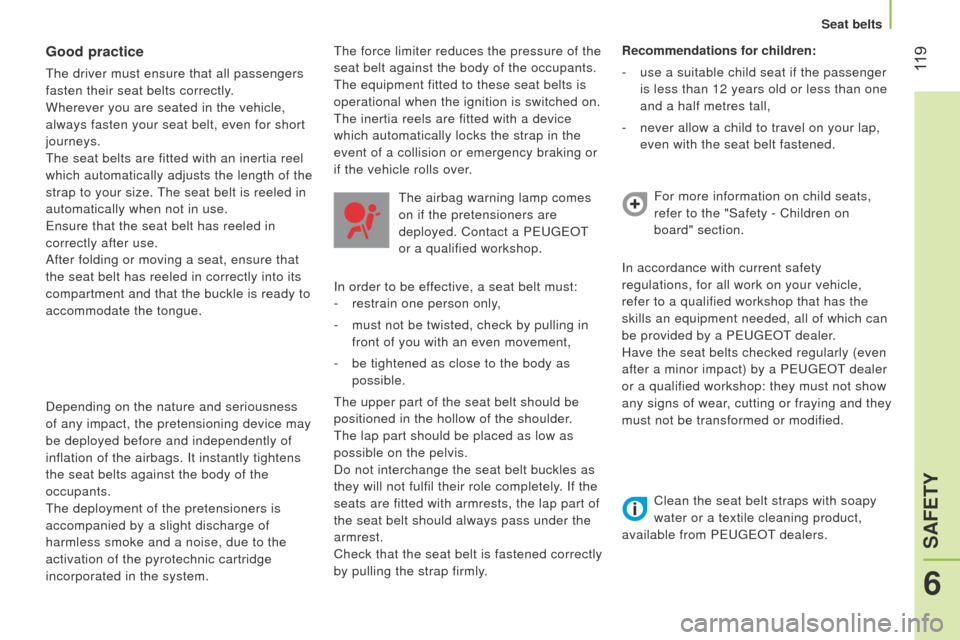
11 9
Bipper_en_Chap06_securite_ed02-2014
Good practice
the driver must ensure that all passengers
fasten their seat belts correctly .
Wherever you are seated in the vehicle,
always fasten your seat belt, even for short
journeys.
t
he seat belts are fitted with an inertia reel
which automatically adjusts the length of the
strap to your size.
t
he seat belt is reeled in
automatically when not in use.
e
nsure that the seat belt has reeled in
correctly after use.
After folding or moving a seat, ensure that
the seat belt has reeled in correctly into its
compartment and that the buckle is ready to
accommodate the tongue.
t
he force limiter reduces the pressure of the
seat belt against the body of the occupants. t he equipment fitted to these seat belts is
operational when the ignition is switched on.
t
he inertia reels are fitted with a device
which automatically locks the strap in the
event of a collision or emergency braking or
if the vehicle rolls over.
t
he airbag warning lamp comes
on if the pretensioners are
deployed. Contact a P
euge O t
or a qualified workshop.
Depending on the nature and seriousness
of any impact, the pretensioning device may
be deployed before and independently of
inflation of the airbags. It instantly tightens
the seat belts against the body of the
occupants.
t
he deployment of the pretensioners is
accompanied by a slight discharge of
harmless smoke and a noise, due to the
activation of the pyrotechnic cartridge
incorporated in the system. In order to be effective, a seat belt must:
-
restrain one person only
,
-
must not be twisted, check by pulling in
front of you with an even movement,
-
be tightened as close to the body as
possible.
t
he upper part of the seat belt should be
positioned in the hollow of the shoulder.
t
he lap part should be placed as low as
possible on the pelvis.
Do not interchange the seat belt buckles as
they will not fulfil their role completely. If the
seats are fitted with armrests, the lap part of
the seat belt should always pass under the
armrest.
Check that the seat belt is fastened correctly
by pulling the strap firmly. Recommendations for children:
-
use a suitable child seat if the passenger
is less than 12 years old or less than one
and a half metres tall,
-
never allow a child to travel on your lap,
even with the seat belt fastened.
For more information on child seats,
refer to the "Safety - Children on
board" section.
In accordance with current safety
regulations, for all work on your vehicle,
refer to a qualified workshop that has the
skills an equipment needed, all of which can
be provided by a P
euge O t
dealer
.
Have the seat belts checked regularly (even
after a minor impact) by a P
euge O t
dealer
or a qualified workshop: they must not show
any signs of wear, cutting or fraying and they
must not be transformed or modified.
Clean the seat belt straps with soapy
water or a textile cleaning product,
available from P
euge O t
dealers.
6
SAFETY
Seat belts